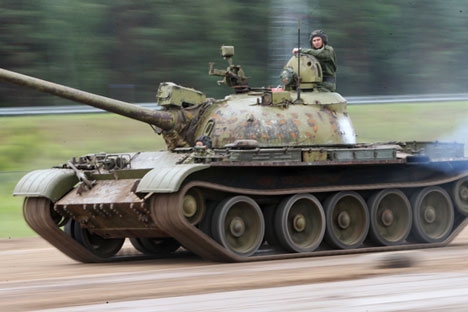
A T-55 tank, 2014. Source: Egor Eryomov / RIA Novosti
No sooner had the Soviet Union adopted the T-54 tank in the late 1940s did the arms race escalate among the former WWII allies, with the sides battling for supremacy in all spheres of defense and arms production. For the USSR, tanks had a special significance in the projection of military might on land, and its masses of tanks hung like the sword of Damocles over Europe for decades.
The Soviet challenge did not go unanswered. The appearance of the U.S. M48 Patton III and the British Centurion battle tank was followed in 1959 by the debut of the U.S. M60 main battle tank. The Mk.10 modification of the Centurion also had Soviet tank builders working overtime to match its improved specifications.
Work to create a new armored vehicle based on the T-54B medium tank began in 1957. Assigned the secret classification of "Object 155," the tank incorporated the entire range of new design features yielded by the modernization of the T-54. Testing ran from the winter of 1957 to the spring of 1958, when Object 155 was adopted by the Soviet Army as the T-55 according to a May 8 resolution passed by the USSR Council of Ministers. Over the course of its lifetime, 24,000 T-55 tanks were to roll off the conveyor in total.
The main improvement over the T-54 was the successor’s comprehensive anti-nuclear defense system, insulating the crew against the effects of radiation. The armor thickness remained the same, as did the weaponry, although the main gun and coaxial machine gun was now stabilized in two planes. The tank’s profile was also reduced by almost one meter.
While thankfully not encountering the Centurion on European battlefields in a new global conflict, the T-55 collided with its rival in numerous. Arab-Israeli conflicts. The Soviet tank proved superior in its road performance but inferior in the effectiveness of its armaments. The British 105-mm L7 cannon afforded the Centurions of the Israeli forces superior sighting range and armor penetration, which proved decisive in the ensuing desert battles. The fighting in the Middle East also revealed shortcomings in the Soviet tank’s structural configuration, which caused the detonation of its ammunition stocks after most penetrations of its armor.
The T-55’s first major clash with the Centurion came in June 1967 during the Six-Day War, which was won by Israel, with 20 Israeli tanks knocking out 32 Egyptian T-54 and T-55 tanks in the Bir Lahfan area. However, conditions favored the Soviet tanks at El-Arish in 1973, when the Egyptians repulsed three attacks by Centurions of Israel’s 7th Brigade, destroying 17 enemy tanks.
Overall, Israel lost 122 tanks of all types on the Egyptian front, while Egypt lost more than 820 of its 935 tanks and self-propelled guns, destroyed and captured, including 82 T-55s. On the Golan Heights, Syria lost 1,116 tanks, including 627 T-54s and T-55s, while Israel lost 250 Centurions and U.S.-built Shermans.
T-55 during military exercises, 1977. Source: Nikolai Akimov; Vladimir Peslyak / TASS
But the Soviet tanks suffered an even greater debacle during the 1973 war when Egyptian forces launched an offensive on October 14 with 1,200 tanks against 750 Israeli Centurion and Patton tanks in the largest armored battle since World War Two. Egyptian tank losses totalled 264 while Israel lost a mere 25 vehicles. The L7 cannon proved devastating against the Egyptian armor at long range, and Israel’s air force dominated the sky over the Sinai desert, leading to more aerial devastation of Cairo’s forces.
By the end of the hostilities, the Israeli tank crews had seen how the L7 tank cannon not only outgunned the 100-mm D-10T2S cannon fitted to the T-55, but also the more advanced 115-mm U5-TC on the Soviet T-62s. The Centurion’s main gun had a greater maximum elevation than its rivals, which often allowed the Israelis to destroy enemy tanks while staying out of reach of return fire.
However, the key to the Israelis’ success was not so much technical superiority as superior military planning and organization of their campaign compared with the Egyptian armed forces.
The Soviets also extensively used the T-55 in the 1979-1989 war in Afghanistan, since the most modern tanks available went to the Western Group of Forces, based in Europe. Meanwhile, army formations on the southern border of the USSR were equipped with already obsolete T-55 and T-62 models. In Afghanistan, these were used in small units to beef up motorized infantry and airborne assault battalions, as well as to secure lines of communication in key areas, functioning as long-range, maneuverable firepower.
While taking plenty of knocks – and knockouts – during its improvement, the T-55 proved itself as a cheap and mechanically simple and robust asset for armies around the globe, seeing service in around 70 countries. Simple to operate compared with Western tanks, it also offered excellent mobility due to a relatively low combat weight of 40 tons, wide tracks (giving lower ground pressure and thus good mobility on soft ground), a reliable good cold-weather start-up system, and a snorkel for river crossings.
As well as in the Middle East, the battlefield stalwart saw action in such far-flung theaters as Angola, Vietnam, the Indo-Pakistan wars, the Balkans, and more recently in Libya. And it is still fighting. In July, 2014, a T-54 from a museum in the eastern Ukrainian city of Donetsk was reportedly commissioned into the rebel forces.
All rights reserved by Rossiyskaya Gazeta.
Subscribe
to our newsletter!
Get the week's best stories straight to your inbox